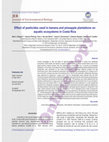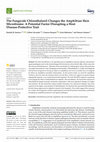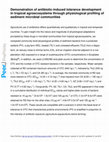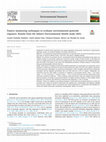Papers by Clemens Ruepert

Ecotoxicology, 2012
The impact of diazinon spraying in an agricultural tropical soil through the evaluation of both t... more The impact of diazinon spraying in an agricultural tropical soil through the evaluation of both the habitat and retention functions of the soil system was never reported. To fill this gap, five times the recommended dose of a commercial diazinon formulation was sprayed in an agricultural area of Costa Rica, and dilution gradients of the sprayed soil were prepared in the laboratory. Avoidance and reproduction tests with soil organisms (Eisenia andrei, Enchytraeus crypticus and Folsomia candida) to evaluate losses in terrestrial habitat function, and growth and reproduction tests with aquatic organisms (Chlorella vulgaris and Daphnia magna, respectively) to evaluate the retention function of soil were performed. Results demonstrated that regarding habitat function, F. candida reproduction was the most sensitive endpoint (EC(50) = 0.288 mg a.i./kg), followed by avoidance behaviour of E. andrei (EC(20) = 1.75 mg a.i./kg). F. candida avoidance and the reproduction of E. andrei and E. crypticus were not affected by diazinon. The toxicity tests with aquatic organisms showed that the soil retention function was insufficient to prevent effects of diazinon either on microalgae growth (EC(50) ≤ 0.742 mg/L and EC(20) ≤ 0.223 mg/L) and on the reproduction of the cladoceran (EC(50) ≤ 0.00771 mg/L and EC(20) ≤ 0.00646 mg/L). Results suggested that diazinon exerted toxic effects even at the dilution corresponding to the recommended dose, fact which makes its misuse an issue of environmental concern. Furthermore, the present study highlighted the importance and complementary nature of the assessment of both habitat and retention functions to an ecological risk assessment in tropical systems.

Revista de Ciencias Ambientales, 2018
Se realizó una evaluación preliminar de la agricultura en las subcuencas Esquinas, Coto Colorado,... more Se realizó una evaluación preliminar de la agricultura en las subcuencas Esquinas, Coto Colorado, Rincón, Conte, Agujas, Tigre y Palma, como criterio base para el diseño de un plan de seguimiento de la calidad del agua que ingresa al estuario. Se determinó el área de los cultivos, mediante interpretación de imágenes satelitales, para un total aproximado de 10 000 ha de arroz Oryza sativa y 31 000 ha de palma aceitera Elaeis guineensis. El uso de agroquímicos se estimó con base en información secundaria publicada y con encuestas administradas a grupos productores. El uso anual estimado de plaguicidas fue de 20.4 kg ha-1 en arroz y 6.6 kg ha-1 en palma, y 840 kg ha-1 año-1 de fertilizantes granulados en ambos cultivos. Asimismo, se hizo un muestreo puntual de residuos de plaguicidas en agua, sedimento y peces, analizados con cromatografía de gases acoplada a espectrometría de masas y cromatografía de líquidos con detector de arreglo de diodos. En todas las muestras de agua se detectó ...

Journal of environmental biology, 2014
Current knowledge on fate and effect of agricultural pesticides comes is mainly from temperate ec... more Current knowledge on fate and effect of agricultural pesticides comes is mainly from temperate ecosystems. More studies are needed in tropical systems in order to assess contamination risks to nontarget endemic tropical species from the extensive use of pesticides e.g. in banana and pineapple plantations. In this study, acute laboratory toxicity tests with organophosphate pesticides ethoprophos and chlorpyrifos were conducted on two Costa Rican species, cladoceran Daphnia ambigua and fish Parachromis dovii. Tests showed that chlorpyrifos was more toxic than ethoprophos to D. ambigua and P. dovii and that D. ambigua was also more sensitive than P. dovii to both pesticides. Additionally, bioassays were performed by exposing D. magna and P. dovii to contaminated water collected from the field. Chemical analyses of field water revealed that fungicides were generally the most frequent pesticide group found, followed by insecticides/nematicides and herbicides. The bioassays and values obt...

During 2008-2010 inventories of chemical reagents used and stored in teaching and research labora... more During 2008-2010 inventories of chemical reagents used and stored in teaching and research laboratories of Omar Dengo and Benjamin Nunez campuses of National University were generated. E ach laboratory coordinator was asked to fill out a form that included name, quantity and CAS number of every chemical reagent stored and utilized in the laboratories. Chemical reagents were then classified according to the risk categories described by the United Nations IMDG Code. Such a classification process allowed the development of distribution patterns of the chemical reagents within the schools, institutes and research centers of Universidad Nacional. In addition, they were identified the chemicals hazardous classes of the reagents of larger and lesser utilization within the university laboratories. An adequate chemical reagent management, along with a classification system based upon risk categories, is necessary in order to establish a safe working environment in university laboratories. Cl...
Background and Aims: In Costa Rica, chlorpyrifos-treated plastic bags are used to protect the ban... more Background and Aims: In Costa Rica, chlorpyrifos-treated plastic bags are used to protect the banana and plantain fruits from insects and to fulfil product standards. The aim of this study was to e...

The skin microbiome is an important part of amphibian immune defenses and protects against pathog... more The skin microbiome is an important part of amphibian immune defenses and protects against pathogens such as the chytrid fungus Batrachochytrium dendrobatidis (Bd), which causes the skin disease chytridiomycosis. Alteration of the microbiome by anthropogenic factors, like pesticides, can impact this protective trait, disrupting its functionality. Chlorothalonil is a widely used fungicide that has been recognized as having an impact on amphibians, but so far, no studies have investigated its effects on amphibian microbial communities. In the present study, we used the amphibian Lithobates vibicarius from the montane forest of Costa Rica, which now appears to persist despite ongoing Bd-exposure, as an experimental model organism. We used 16S rRNA amplicon sequencing to investigate the effect of chlorothalonil on tadpoles’ skin microbiome. We found that exposure to chlorothalonil changes bacterial community composition, with more significant changes at a higher concentration. We also f...
Introduction: At banana plantations, weekly aerial applications of mancozeb, a ethylene bisdithio... more Introduction: At banana plantations, weekly aerial applications of mancozeb, a ethylene bisdithiocarbamate (EBDC) fungicide, are performed to protect bananas from Sigatoka disease. This study aims ...
Marine Pollution Bulletin

Agricultural use of antibiotics differs quantitatively and qualitatively in tropical and temperat... more Agricultural use of antibiotics differs quantitatively and qualitatively in tropical and temperate countries. To gain insight into the nature and magnitude of physiological adaptations prompted by these drugs in microbial communities from tropical agroecosystems, we compared community-level physiological profiles of sediment bacteria from a protected wetland (PV), a pig farm (RD), treated (TIL1) and untreated effluents (TIL2) from a tilapia farm, an estuary close to shrimp farms (CA), and an irrigation channel adjacent to a rice plantation (AZ) exposed to a range of oxytetracycline (OTC) concentrations in Ecoplates (Biolog®). In addition, we used LC/MS/MS and plate counts to determine the concentration of OTC and the number of OTC-resistant bacteria in the samples, respectively. Water samples collected at RD contained maximum amounts of OTC (640 ng L-1), followed by TIL2 (249 ng L-1), TIL1 (72 ng L-1), and CA (85 ng L-1). In average, the microbial community of RD was more tolerant t...
MEDICAL DEVICES & SENSORS

Science of The Total Environment
Conventional banana cultivation in Costa Rica relies on heavy pesticide use. While pesticide resi... more Conventional banana cultivation in Costa Rica relies on heavy pesticide use. While pesticide residues in exported bananas do not generally represent a safety concern for consumers abroad, ecosystem and human health in producing regions are not likewise protected. In Costa Rica, most studies on pesticide residues in the environment are snapshots, limiting our ability to identify temporal dynamics that can inform risk mitigation strategies. To help bridge this gap, we created a dynamic multimedia model for the Caño Azul River drainage area, which is heavily influenced by banana and pineapple plantations. This model estimates chemical concentrations in water, air, soil, sediments, and banana plants through time, based on pesticide properties and emission patterns and on variable environmental conditions. Case studies for three representative chemicals-the herbicide diuron, the nematicide ethoprofos, and the fungicide epoxiconazole-show that concentrations in fruit remain below EU and US maximum residue limits set to ensure consumer health, while those in the environment are highly variable, reaching peak concentrations in water that can exceed thresholds for ecosystem health. Critical research needs, including incorporating sediment dynamics and the effects of adjuvants on the properties and transport of active ingredients into multimedia models, were identified.

The Science of the total environment, 2017
Chemical analysis of raw wastewater in order to assess the presence of biological markers enterin... more Chemical analysis of raw wastewater in order to assess the presence of biological markers entering a wastewater treatment plant can provide objective information about the health and lifestyle of the population connected to the sewer system. This work was performed in a tropical country of Central America, Costa Rica, with the aim of extending this knowledge to new world regions. This work is the first to report wastewater-based epidemiological data on the use of illicit drugs in this region of the world. Composite wastewater samples from the influents of two different wastewater treatment facilities and surface water samples from surrounding areas were collected applying the best practice protocol and analysed to investigate the occurrence and fate of selected illicit drugs of abuse and pharmaceuticals. Results showed the presence of chemical indicators of the classic drugs cocaine and cannabis at high concentration levels, besides the moderate presence of the opiates codeine and m...

Environmental Science and Pollution Research, 2017
The Caño Negro Ramsar wetland is a conservation area of great natural and societal value, located... more The Caño Negro Ramsar wetland is a conservation area of great natural and societal value, located in the lower part of the Frío River watershed in the north of Costa Rica. Its aquatic ecosystems may be considered vulnerable to pollution due to recent changes in land use toward agriculture. In 2011 and 2012, quarterly sampling was done at ten sites located in the middle and lower sections of the Frío River Basin that pass through crop areas and later drain into Caño Negro wetland. Pesticide residues, nitrates, sediment concentrations, and diversity of benthic macroinvertebrates and fish biomarkers were studied in the selected sites. Additionally, risk of toxicity was calculated in two different ways: (1) by using a ratio of MEC to hazard concentrations threshold for 5% of species (HC5) to calculate a risk quotient (RQ), and (2) by using a ratio of MEC to available ecotoxicity data of native fish and cladocera for diazinon and ethoprophos, to obtain a risk quotient for native species (RQns). Results indicated that three out of the ten sites (rivers Thiales, Mónico, and Sabogal) showed variable levels of pollution including six different active ingredients (a.i.) of pesticide formulations (herbicides ametryn, bromacil, and diuron; insecticides cypermethrin, diazinon, and ethoprophos). Moreover, potential adverse effects on fishes in Thiales and Mónico rivers were indicated by cholinesterase (ChE) inhibition and glutathione S-transferase (GST) enhancement. Risk evaluations indicated pesticide residues of ametryn, bromacil, and ethoprophos to be exceeding the limits set by MTR, also RQ was high (>1) in 70% of the positive samples for diuron (most frequently found pesticide in water samples), cypermethrin, diazinon, and ethoprophos, and RQns was high for diazinon. Therefore, these substances might be of major concern for the ecological health of aquatic ecosystems in the middle basin of the Frío River. The most critical site was Mónico River, which had the highest pollution (75% detection samples with 3-5 a.i.) and highest calculated risk (RQ > 1 in 75% of the samples). This is also the river that most directly drains into the protected wetland. Even though pesticide pollution in this area is not as severe as in other parts of Costa Rica, it is imperative that measures are taken, particularly in the surroundings of Mónico River, in order to diminish and mitigate possible detrimental effects to biota in Caño Negro Ramsar Site.

Agronomía Mesoamericana, 2014
El objetivo del presente trabajo fue realizar un diagnóstico de uso de plaguicidas y otros agroqu... more El objetivo del presente trabajo fue realizar un diagnóstico de uso de plaguicidas y otros agroquímicos, a los productores de papa en Cartago, Costa Rica. Se emplearon cuestionarios de campo entre los años 2006 y 2009 en la microcuenca de las quebradas Plantón y Pacayas. Cada productor como promedio utilizó 32,8 kilogramos de ingrediente activo (i.a.) de plaguicida por hectárea por ciclo, en un rango de 10,9 a 88,3. Como uso ponderado por hectárea se calculó un valor de 42,6 kg i.a./ha/ciclo para plaguicidas y de 1879 kg de fertilizante formulado/ciclo. El grupo de mayor uso lo constituyeron los fungicidas-bactericidas con 30 i.a. y 85,7% del total de plaguicidas, le siguen los insecticidas (25 i.a. y 11,0%) y los herbicidas (4 i.a. y 3,3%). El agroquímico de mayor uso fue el mancozeb, seguido de propineb y clorotalonil; otros productos de alto empleo fueron fosetil aluminio, cartap, metamidofos, paraquat y endosulfan. Se utilizaron agroquímicos no registrados para papa y con recono...

Background: Pesticides used in agriculture may expose populations living nearby. Costa Rica is a ... more Background: Pesticides used in agriculture may expose populations living nearby. Costa Rica is a major banana-exporting country, its production depends on extensive pesticide use. Objectives: To evaluate environmental pesticide exposure, we measured levels of current-use pesticides in air and dust from 12 schools in Matina County, Costa Rica, with passive sampling methods. Methods: We selected ten proximal and two non-proximal schools and placed polyurethane foam passive air samplers outdoors at each school, during four consecutive periods. At three of these schools, we also placed an active air sampler during the first 24 h of each sampling period. We collected passive dust samples by placing a glass Petri Dish at the inside of each school. We subsequently performed a chemical analysis of 18 pesticides, using gas chromatography with mass detector. Results: With passive air samplers we detected ten different pesticides: two insecticides, two nematicides, and six fungicides, of which...
Encyclopedia of Pest Management, Volume II, 2007











Uploads
Papers by Clemens Ruepert